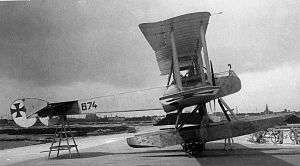Gotha WD.7
| WD.7 and WD.8 | |
|---|---|
 | |
| Role | torpedo-bomber trainer and reconnaissance |
| National origin | Germany |
| Manufacturer | Gotha |
| First flight | 1916 |
| Primary user | Imperial German Navy |
|
| |
The Gotha WD.7 (for Wasser Doppeldecker - "Water Biplane") was a reconnaissance floatplane developed in the German Empire during World War I.
Development

After the pusher WD.3 was not accepted by the Imperial German Navy, Gotha turned to a new layout that would keep the aircraft's nose free for forward-firing weapons. The WD.7 therefore, was a conventional biplane with twin engines mounted tractor-fashion on the leading edge of the lower wing. Eight examples were built for use as trainers for torpedo bombing. During 1917, two of these aircraft were used for testing a 37 mm (1.46 in) autocannon built by DWM.
The same airframe was used to create the WD.8 reconnaissance floatplane, substituting the twin wing-mounted engines with a single Maybach Mb.IVa in the nose.
Variants
- WD.7
- twin-engine torpedo bomber trainer floatplane
- WD.8
- single-engine reconnaissance floatplane
Specifications (WD.7)
General characteristics
- Powerplant: 2 × Mercedes D.II, 90 kW (120 hp) each
References
| Wikimedia Commons has media related to |
- Taylor, Michael J. H. (1989). Jane's Encyclopedia of Aviation. London: Studio Editions. p. 428.
- World Aircraft Information Files. London: Bright Star Publishing. pp. File 895 Sheet 09.